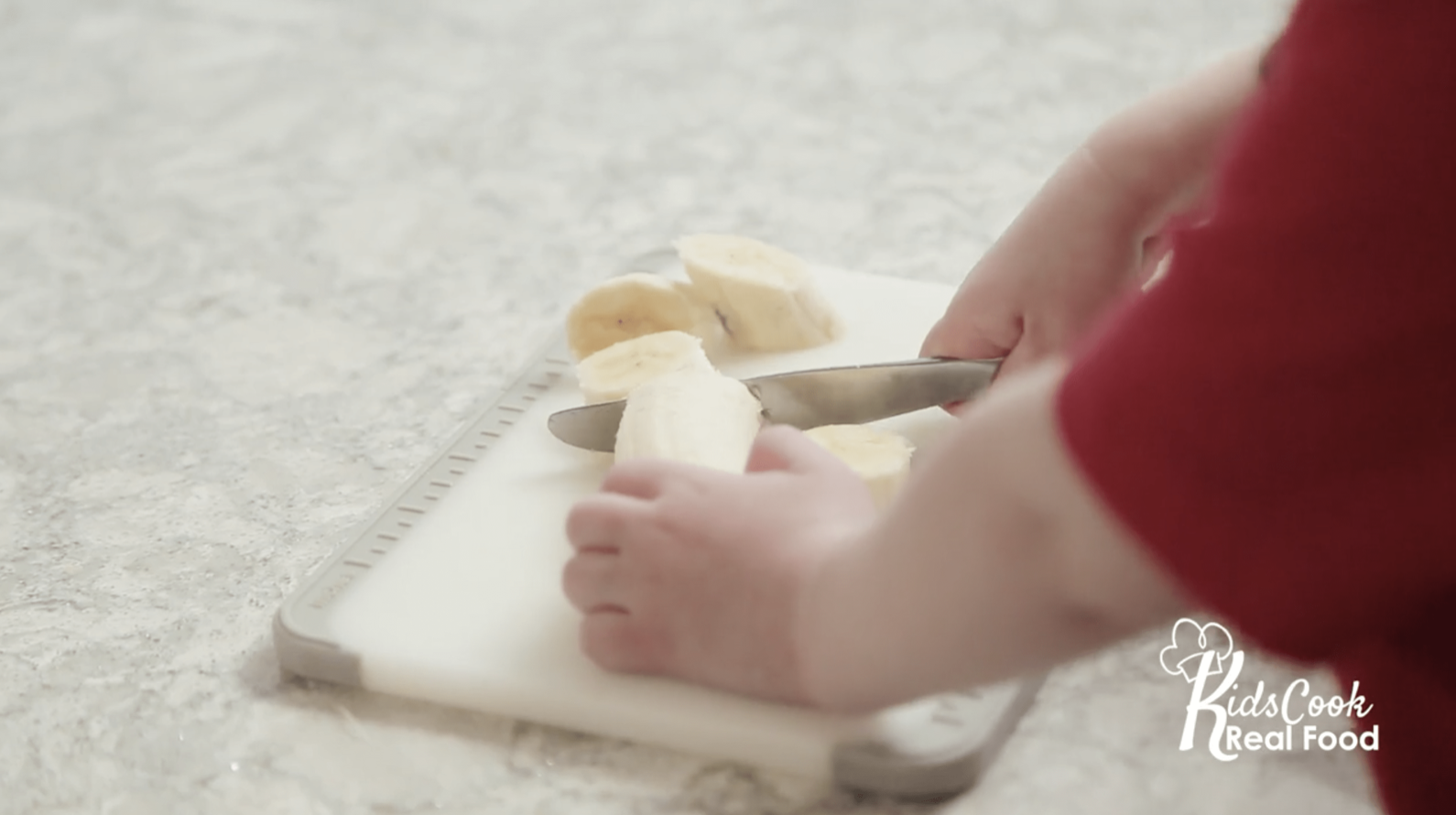
Podcast Episode #50: Kids Eating Healthy
Today Katie Kimball of Kitchen Stewardship and Kids Cook Real Food tells us how to start our babies and get our toddlers eating healthy food. Don’t forget her free download – 10 Snacks your Preschooler Can Make Today! You can listen to this complete podcast episode on iTunes or SoundCloud.
Alyssa: Hello! Welcome to another episode of Ask the Doulas. I am Alyssa Veneklase, co-owner and postpartum doula. And today we’re talking to Katie Kimball again of Kitchen Stewardship. Hi, Katie.
Katie: Hey, Alyssa. Thanks for having me!
Alyssa: Yeah! So we are going to talk today – we talked to you last time about having kids in the kitchen, but we want to kind of shift gears and talk about how to get good eating habits started early for our kids and then get some tips from you on how to do it, especially through those toddler years when they seem to be picky and hate everything you put in front of them. How do you deal with that?
Katie: Yes, we can do this!
Alyssa: I guess where would you tell a parent to start?
Katie: Well, so the big word that I’ve picked up – I have 4 kids, and so I’ve been a mom for 13 years; kind of been around the block with this. And I was so stressed about feeding my child when my first was a baby. I remember nearly karate-chopping my husband’s uncle in the arm because he had some Cool-Whip on his finger and was going to offer it to my seven-month-old. I was like, “No! You can’t! No!” Right, that was going to literally kill him. I’m not a fan of Cool-Whip, but I could have chilled out a little more. I did a great, really informative to me, interview with a naturopath who specializes in kids’ nutrition a few years back, and she said, actually, the most current research shows that it’s the most important for kids’ palettes and mouths and bodies to be exposed to the widest variety of foods possible, even before six months, even before seven months, like when we’re usually starting to feed at six months. So just allowing them to smell or just have little licks, little tastes, of everything you’re eating. It’s almost like an inoculation. It’s almost like an inoculation to the world where they’ll be less likely to get allergies. And here, again, 13 years ago when my youngest was a baby, we were told do NOT give them any highly-allergenic foods until after one; you know, no peanuts until after two. So we do what we can with what we know, but that’s the most current research, actually, is that we just kind of need to expose them to all sorts of foods, and even up until 12 months, the function of the sitting-up kind of eating with a spoon or on a high chair tray is mostly just exposure and exploration. And so that takes a lot of pressure off Mom. It’s not about calories. It’s not about nutrition. They’re getting that from the breastmilk or formula they’re drinking.
Alyssa: Right. Yeah, I love the word “exploration” because, you know, around that four- to six-month mark, that’s really all they’re doing is exploring, and my daughter, before she wanted to eat solid foods, would lick, you know. I would give her little tastes of soup or whatever it was off my finger, and she would love it. And that’s such a great tip for parents with babies. Just let them try it. See what happens. They’re not chewing. They’re not going to choke.
Katie: Yeah. So I’m not a huge proponent of baby food, especially the cereal, because there isn’t much nourishment in that, so why are we pushing it so hard? But really just putting little mushy things or finger-food things on the tray and letting them explore. As long as everything is whole foods, I don’t think you can go wrong. Now, no added sugars, of course, right? We don’t want any food coloring, you know. But if it’s little pieces of avocado and little pieces of ground beef or a bean, you know, a little black bean that you mush under your thumb so that it’s not too round. There’s so many soft foods that are just soft or that you can cook to be soft and the kids can just explore. So that’s kind of a nice load off of a mom’s mind that, chill. Chill is the word of the day when it comes to feeding your babies.
Alyssa: So what do you do, then, when it’s like, oh, I’ve done such a great job; my kid will eat anything – and then they turn two, and what the heck happened?
Katie: Oh, my gosh. It happens to almost every family, and the good news is it’s completely developmentally appropriate because at age two to three, the kids are realizing that they’re separate from their parents, and, oh my goodness, they have opinions, you know, and they’re really testing their boundaries. So they’re trying to figure out where my will ends and where my parents’ begins. So they’re going to test that in every way they can, but especially when it comes to eating, sleeping, and pooping, because those are the things we cannot force them to do.
Alyssa: Right, right.
Katie: No matter how hard we try, much to parents’ chagrin. And so again, the good news is you’re really going to have to chill and realize that it’s normal, totally normal for them to say no to something they used to like, even if they liked it yesterday. They may say no to it today. They might like it again tomorrow. And so I often tell parents who are in that phase, that picky eating phase from two to five, that you just have to be more stubborn and more persistent than your child until they turn six-ish.
Alyssa: Yeah, my daughter just did that to me the other day. She’s five, and she has loved avocados and guacamole for years, and then all of a sudden, she didn’t. Then she told me last week, “Mommy, I decided I like avocados again.”
Katie: It is tough, and I think the risk is if we give in, if we’re like, “Oh, she doesn’t like avocados or guacamole anymore, so I just won’t serve it ever.” Well, then she probably never would have come back around to it, or the chances would be slim. So our job as parents is just to continue to serve good, healthy foods. Obviously, you have to be eating good, healthy foods, but serving whole foods and a variety of fruits and vegetables and protein sources and expecting that they will change over time. I think in America, especially, unfortunately, we fall into this terrible rut of feeding kids what they like and then complaining that they’re not eating better. And it’s like, well, that’s because your expectations are this teeny-tiny box of what they like, and they’re not going to push out of that. So we’ve got to raise our expectations and realize, you know, that our 20-something year old child’s palette is not going to be the same as our 3-year-old’s, and so we’re just going to continue to offer good things and feed them good things, and they can choose how much they eat and when they eat, as long as we’re not letting them feast on junk food outside of meals. We can win. We can win after they’re in, like, first grade. They come around to all the green things.
Alyssa: Yeah, that’s good. It gives us hope, right?
Katie: Yes!
Alyssa: And it’s funny that you say “in America” because every time I go to a restaurant and you look at the kids’ menu, there’s always the same five options. It’s mac and cheese. It’s a hot dog. It’s a hamburger. It’s a cheeseburger. You know, and it’s all unhealthy. They don’t have any good options, so I end up having to split, like order one healthy meal and split it with my daughter, and it is really frustrating when you’re trying to have your children eat healthy, but there’s no healthy options on a kids’ menu.
Katie: Yes, it’s counter-cultural to feed our kids vegetables, so we have to be really ready, like we would anything for our kids, right? Ready to be the mama bear and put up the fight.
Alyssa: Right, right. And I have to ask all the time, “Do you have any vegetables that I could add instead of fries?” And they’ll look at me, like, well, what kind of vegetables? Anything!
Katie: It’s getting better. I have to say, the pendulum is swinging in the right direction, and it’s very exciting to watch and to push it as hard as I can.
Alyssa: Well, you have created a PDF for us to help parents who maybe have had trouble with the process of getting their kids to eat healthy foods, and it’s 10 Snacks Your Preschooler Can Make Today. Tell us where can we find it and what’s on this, and maybe a couple of the ten snacks that are on there?
Katie: Sure thing. Well, you can download that for free. And the idea here is that one way to get kids to eat better – because, again, they’re testing those boundaries – one way to get those young preschoolers to eat better is to get them involved because when they get involved, whether it’s growing food, choosing it at the grocery store or farmer’s market, planning a meal, preparing a meal, serving a meal – any involvement in any way helps them to feel connected to that food and they’re much, much more likely to try it joyfully or at least be open and having a better attitude at the meal. So we want to get those kids in the kitchen, you know, using tools, and so we teach them simple things like using a butter knife to slice bananas or make ants on a log and different ways to slice cheese. There’s actually a homemade gelatin in there that uses 100% grape juice, which is still not health food, but it’s way better than Jello from the box. And it’s really fun. It’s a really fun activity for kids to make with an adult. So some of the recipes in there are things a three-year-old could do pretty much start to finish, and then some are kind of a half-and-half, like a fun thing for a kid to do with a parent.
Alyssa: Yeah, I think that’s a great tool. You know, kids that age love to be involved, but in a sense, they’re kind of followers. They like to do what their friends are doing. They want to do what you’re doing, and if they know that you’re cooking and they’ve helped, they see that as something that they want to take part in, and they will probably eat it or at least try it, right? They’re more likely to try it.
Katie: Yeah, it totally increases your chances, and the pickier a child is – and some kids really have some processing issues where food maybe tastes so bold and vibrant to them that any new food is nearly terrifying because they’re afraid that it will overwhelm their senses, and that’s becoming more and more common, and it’s okay. We can work within what our kids’ bodies are telling us, and it’s still, even with sensory processing disorder, the goal is still continual exposure. So a normal kid might need two or three or ten exposures to, let’s say, broccoli. A kid who’s processing the senses a little different might need 50 or 100. It’s a little bit a longer game with them, and you have to be really patient. And that’s not every kid. That’s just the ones that are so picky. Their tags are itchy. They don’t like any spicy foods, or maybe they like only really spicy foods. This is kind of a segue, but the ones who are saying my kid is way pickier than that – it’s still the same process; it’s just a long time and continuing to be patient and expose them.
Alyssa: Yeah, it’s a lot of patience for the parents then.
Katie: Yes.
Alyssa: Again, a daily struggle, right?
Katie: Yes!
Alyssa: Is there anything that we didn’t mention about tips for our toddlers?
Katie: Be consistent; keep the sugar out. Actually, the grandma training is something I like to talk to parents about. It’s not only grandmas, but some other adults in our lives, and sometimes us, too; we just want to love our kids through suckers and popsicles, and so it’s been my mission in life to train the grandma in our life who tries to do that that it’s not depriving a child if they don’t know what it is.
Alyssa: Right!
Katie: So candy is this secretive thing that my children have no idea exists, for as long as humanly possible, because if they don’t know it exists, it’s not a battle; it’s not a struggle, and it’s certainly not a deprivation. They just think raspberries are the most amazing thing ever encountered, right? So a bowl of raspberries is as good to them as a bowl of gummy bears. So that’s a super thing, if you’ve got a really young child. Just keep all the junk food as an unknown in their world.
Alyssa: Yeah, I think that is a really hard thing. You know, we teach a grandparents’ class for other reasons, but part of that is the struggle that this different generation doesn’t understand that sugar is a bad thing. They learned that sugar just rots your teeth. They have no idea that it does all the other bad things that it does to us internally, and starting our kids off so young with sugar in everything – sugar cereals and candy and just everything. They don’t get it, and it becomes a source of contention between the grandparents and the parents.
Katie: Totally, yeah. They think we’re depriving our kids of the joy of life, right? And it’s been fun, actually, watching my mother-in-law just see our kids. Like my third child literally asks for a bowl of feta cheese, like a container of feta cheese, to himself for his birthday from her. And it cracks her up, but I think she’s finally getting it. Like, if you don’t let them know that the craziness is out there, they’re happy. They’re still super happy, and you can give them love in many other ways other than sugar, including through food, like real, whole, healthy food.
Alyssa: That’s great advice! Well, tell our listeners again how to find this PDF.
Katie: Yeah, so 10 Snacks Your Preschooler Can Make Today at our website. It’s a free download, and we’re so excited to share that with you.
Alyssa: I’m so excited to download it for my daughter and do it today!
Katie: Good deal.
Alyssa: All right, well, thanks for visiting us again. Hopefully we’ll talk to you soon!
Katie: Absolutely. Thank you, Alyssa!
Alyssa: And you can always email us at info@goldcoastdoulas.com and find us on Facebook and Instagram. Remember, these moments are golden.


